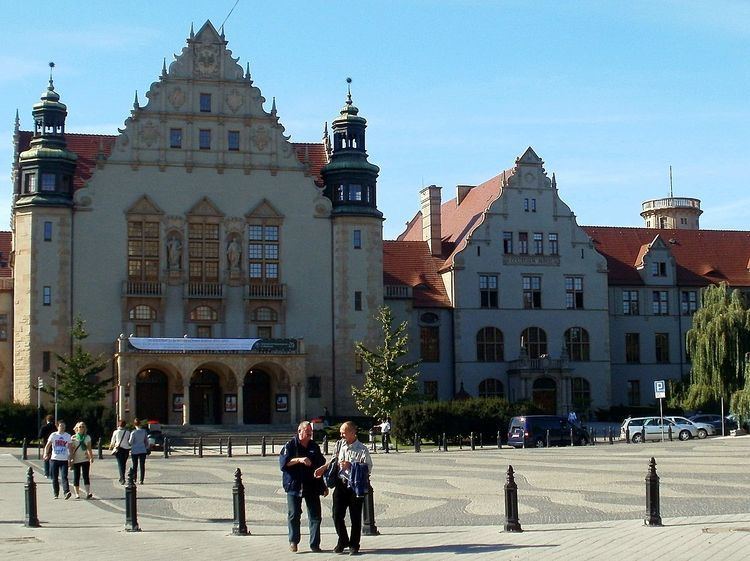Students 49,038 Total enrollment 50,000 (20 Jun 2011) Founded 1919 | Established 1919 Phone +48 61 829 40 00 Rector Bronisław Marciniak | |
 | ||
Address Wieniawskiego 1, 61-712 Poznań, Poland Undergraduate tuition and fees International tuition: 5,850 EUR (2011) Notable alumni Similar Poznań University of Econo, Poznań University of Techno, Nicolaus Copernicus University, Jagiellonian University, University of Life Sciences Profiles | ||
Adam mickiewicz university in pozna poland
Adam Mickiewicz University in Poznań (Polish: Uniwersytet im. Adama Mickiewicza w Poznaniu, Polish abbreviation UAM) is one of the major Polish universities, located in the city of Poznań in western Poland. It opened on May 7, 1919, and since 1955 has carried the name of the Polish poet Adam Mickiewicz. The university has been frequently listed as a top three university in the country.
Contents
- Adam mickiewicz university in pozna poland
- Welcome to the faculty of english of adam mickiewicz university in pozna 2013
- History
- Sites
- Staff and student numbers
- Degrees and faculties
- Notable alumni and honorary doctors
- List of rectors
- International cooperation
- References
Welcome to the faculty of english of adam mickiewicz university in pozna 2013
History
The university was ceremonially opened on May 7, 1919 (the 400th anniversary of the foundation of Poznań's Lubrański Academy). It was originally called Wszechnica Piastowska ("University of the Piasts" – wszechnica being a less common Polish word for "university"), and in 1920 was renamed Uniwersytet Poznański ("Poznań University"). For the first 20 years it educated students in law, economy, medicine, humanities, mathematics, natural sciences, agriculture and forestry.
In 1920 famous sociologist Florian Znaniecki founded the first Polish department of sociology at the university, one of the first such departments in Europe. In the same period of the university's history, botanist Józef Paczoski founded the world's first institute of phytosociology.
After the invasion of Poland, Poznań was annexed by Germany and the University was closed by the Nazis in 1939. It was reopened as a German university in 1941, which operated until 1944. Staff and students of the Polish university, some of them expelled by Germans to Warsaw, opened an underground Polish "University of the Western Territories" (Uniwersytet Ziem Zachodnich), whose classes met in private apartments (see Education in Poland during World War II). Many of the professors and staff were imprisoned and executed in Fort VII in Poznań, including professor Stanisław Pawłowski (rector in the years 1932-33). The Polish university reopened, in much smaller form, after the end of World War II. In 1950, the Medical Faculty, including the Dentistry section and the Faculty of Pharmacy, were split off to form a separate institution, now the Poznań University of Medical Sciences. In 1955 Uniwersytet Poznański adopted a new patron, the 19th-century Polish Romantic poet Adam Mickiewicz, and changed to its current name.
Sites
The university's central administrative building is Collegium Minus, on the west side of Adam Mickiewicz Square at the western end of the street Święty Marcin. (This is one of a group of buildings, including the Imperial Palace, built in the first decade of the 20th century while Poznań was still under German rule; it originally housed a Royal Academy.) Adjoining this is the Aula, which is frequently used for ceremonies and for classical music concerts, and Collegium Iuridicum (accommodating the law faculty). Some teaching takes place in Collegium Maius, another of the aforementioned group of buildings (on ul. Fredry), although this is mainly used by the medical university. Other buildings in the city centre include former communist party headquarters on Święty Marcin, Collegium Novum (used mainly for language teaching) on Al. Niepodległości, and the university library on ul. Ratajczaka.
The university also uses a number of other buildings in southern and western districts of Poznań. However it is strongly developing its site at Morasko in the north of the city. As of 2006, the faculties of physics, mathematics and computer science, biology, geographical and geological science had moved to the new location. In 2015 they were joined by the faculty of history (Collegium Historicum).
The university also has external branches in other towns of western Poland, including Kalisz, Ostrów Wielkopolski and Słubice.
Staff and student numbers
At the start of the 2008/2009 academic year, the university had 46,817 undergraduates (including about 18,000 on weekend or evening courses), 1308 doctoral students, and 2247 other post-graduate students. The number of undergraduates declined slightly between 2005 and 2008.
At the end of 2008, the university had a total of 2892 teaching staff, including 257 full professors and 490 associate/assistant professors. It also had 2120 other employees.
Degrees and faculties
Like most Polish universities, Adam Mickiewicz University awards the following degrees:
The university has the following faculties:
Notable alumni and honorary doctors
Among the University's most famous graduates are:
Recipients of honorary doctorates from the University include Marshal Józef Piłsudski, Marshal Ferdinand Foch, Marie Curie, Ignacy Paderewski, Roman Dmowski, Witold Hensel, Wisława Szymborska, Ernst Håkon Jahr, Al Gore and John Maxwell Coetzee.
